“The fellow that can only see a week ahead is always the popular fellow, for he is looking with the crowd. But the one that can see years ahead, he has a telescope and he can’t make anybody believe that he has it.
-Will Rogers
We are going to witness this miraculous experiment with NASA’s James Webb Space Telescope’s ability to see back in time. It is specifically designed to look into the past and unravel the mysteries of the creation and formation of our solar system, galaxies and other exoplanetary systems existing in the universe.
Space enthusiasts are amazed and moved by the thought of how James Webb Space Telescope will see back in time and that also leads to the major revelations of what we are lacking to conclude in the theories of creation of all sources and the crucial processes that are required to build and formulate such tremendous masses capable of providing life and habitat for numerous species.
Recent posts about JWST’s First Images
What is the major light source for JWST?
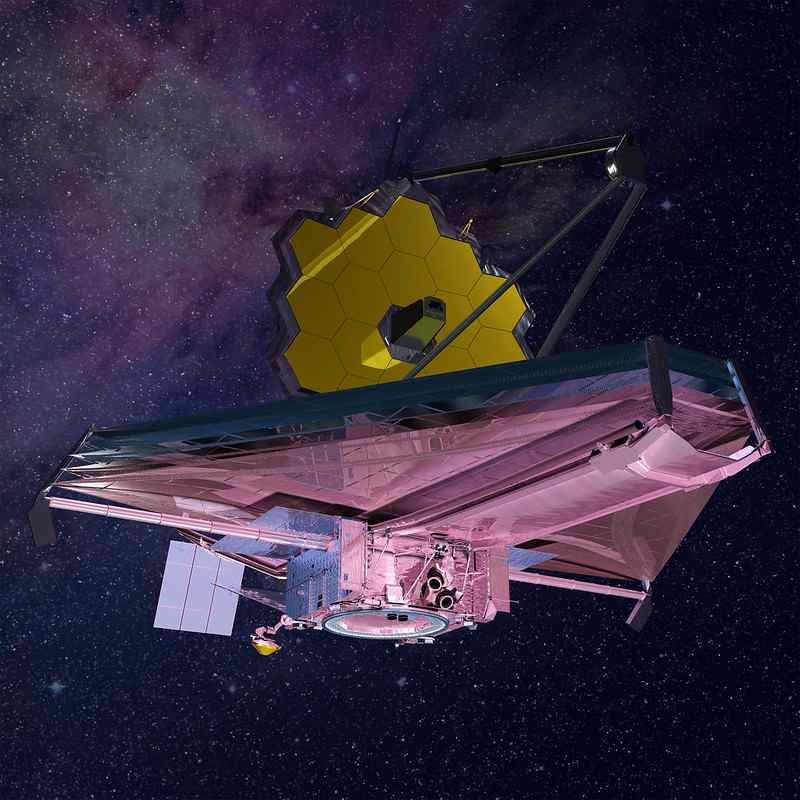
JWST is designed to capitalize and look into the infrared part of the spectrum that ranges from 0.6 (Red light) to 28 microns. It is also designed to see ultraviolet light like Hubble, but also has an added advantage of capturing bright objects like extremely distant galaxies and planets. This is what enables it to really look into the past as light takes a major amount of time to reach JWST onboard reflectors.
Light travels in different ranges of frequencies along with the known electromagnetic spectrum. We have evolved to adapt to seeing band of spectrum which is commonly called ‘Visible light’, which is not so surprising as our atmosphere filters out many other wavelengths and also some of us cannot see neither outside nor inside of our surroundings.
Infrared light is like a north star as it has a longer wavelength and can pass through the objects in space which visible light cannot, also blocked by gas and dust present there. JWST enables us to detect infrared frequencies by picking out objects beyond these clouds, which improves our understanding of clarity.
Related
NASA’s Webb Telescope Stuns With Deepest Infrared Image of Universe Yet
What makes JWST more powerful than others?
The most crucial part that usually enables James Webb Space Telescope to see back in time is its ginormous sunshield which is half as big as 737 aircraft and about the size of a tennis court with an aperture of 6.5 metres across the shield.
By equipping it with a wide and vast sunshield which also helps in cooling the telescope. It is quite crucial for all the Space Telescope but more particular with the infrared telescope like JWST as ‘Warm’ objects radiate and emit a lot of infrared light.
If the telescope itself isn’t kept cool, then it risks itself with the light of any object it is attempting to observe and that makes it near to explode with recurring currents of heat.
The major improvement here though is the telescope aperture, which is effectively the size of the hole at the bare end of the telescope, and in the case of telescopes like JWST, the size of the mirror matters, which is used to collect the light.
The larger the aperture, the more light the telescope can gather in one go and so the fainter an object it can see.
Hubble, with its 2.4 metre aperture, can see objects at least 60,000 times fainter than the human eye (which is then greatly extended by using cameras to take long exposure photographs).
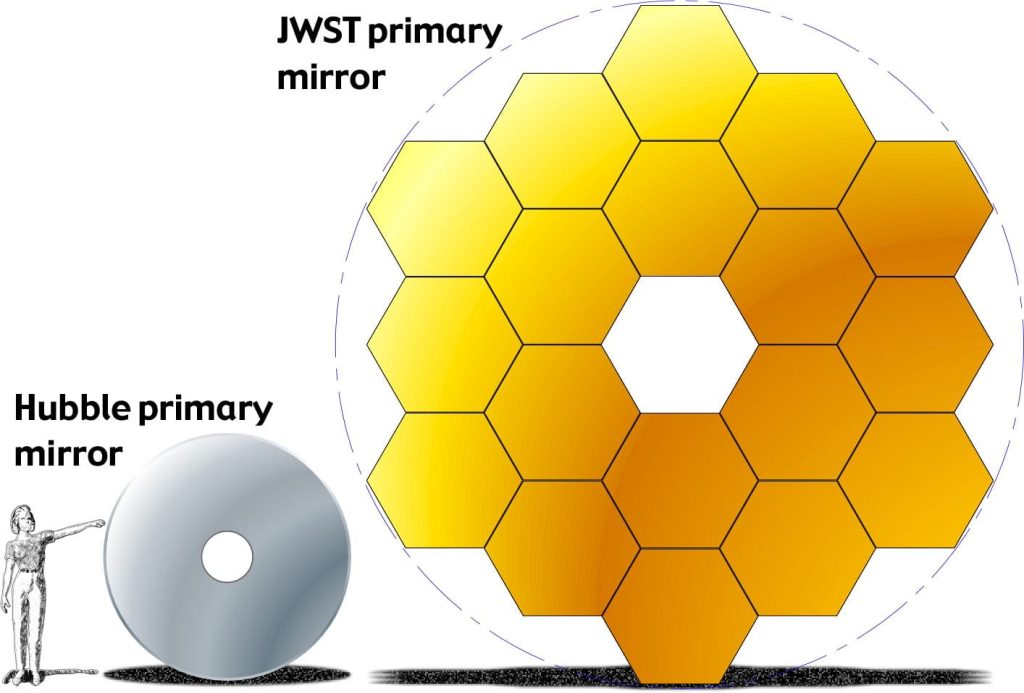
With a mirror almost three times wider, JWST will be able to see objects almost nine times fainter than Hubble, allowing us to peer even further into space and also enable us to steer back in time.
How farther can JWST see in the past?
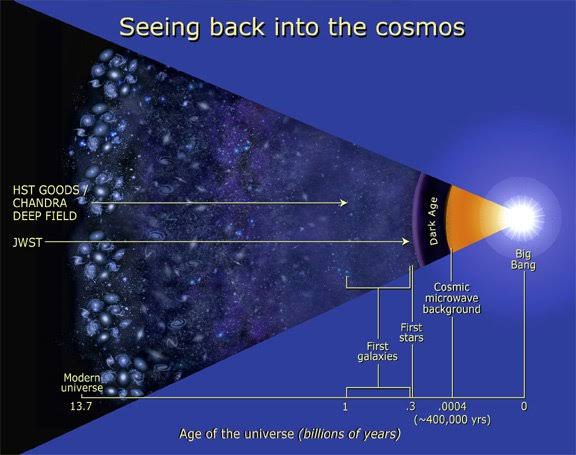
One of the major goals and target of launching or developing this mission was to see the abnormalities and procedures of formulation of planetary systems, galaxies and stars, thereby granting us the superpower of looking back in the past.
The major principle behind this module is light coming from the farther objects like stars takes an ample amount of time to reach to Telescope, so the further away an object is, the further back in time we are looking.
Because of JWST’s larger mirror, it will enable us to see almost the major way back to the beginning of the Universe, around 13.7 billion years ago.
It will be capable of seeing some of the most distant galaxies in our Universe, certainly with more ease than the visible/ultraviolet light view of Hubble.
This is because light from distant objects is stretched out by the expansion of our Universe, an effect known as Redshift pushing the light out of the visible range and into infrared.
Read more about JWST
Understanding The Theory behind JWST seeing back in time:
Simply understand this fact that when telescopes look at the light from distant galaxies, they are not literally looking back in time. The past no longer exists, so no one can directly look at it. Instead, the telescopes are looking at the present-time pattern of a beam of light.
Since the beam of light has been traveling through the mostly empty vacuum of space for millions of years, it has been largely undisturbed.
Therefore, the present-time pattern of this beam of light is the same as the pattern that it had when it was first created by the distant galaxy millions of years ago.
By looking at the present-time state of a beam of light, we can thus infer what the galaxy that created the light looked like millions of years ago.
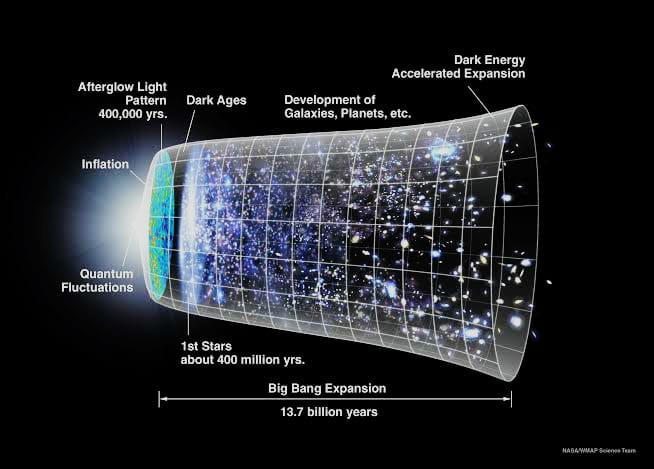
Explaining with an Example
Let’s understand it with more clarity by taking a short example. It’s like taking and printing a photograph of your son as a baby, and then looking at the photo ten years later.
When you look at the printed photo, you are figuratively “looking back in time” and seeing what your son looked like as a baby.
But you are not literally looking into the past. Your son is no longer a baby and does not exist as a baby in any dimension or corner of the universe.
Rather, you are looking at a present-time pattern of light that is being created by the reflection of the room’s light from the inks in the printed photograph.
The ink in the photo has specifically been organized into a pattern resembling your son as a baby, and because the ink pattern has not changed over the last ten years, the present-time beam of light from the photograph has the same pattern as the beam of light that came from your baby son ten years ago.
By looking at a present-time bundle of light, you are able to infer how people looked in the past. But implicitly in this inference, there are three assumptions:
- The camera accurately captured the pattern of light and converted it to a pattern of information.
- The printer accurately transferred this information to a pattern of ink on the printed photo.
- The photo has not changed since it was printed.
All of these assumptions must hold true in order for the pattern of light presently coming from the photo to represent the appearance of your son ten years ago.
For instance, suppose a bit of ink drops on the photo and causes a big blue dot to appear above your son’s head.
If you were literally looking back in time when looking at the photo, you would have to conclude that there was a UFO or ball hovering above your boy’s head ten years ago.
But you are likely smart enough to realize that you are not literally looking back in time, but are simply looking at a present-time pattern of light which no longer exactly represents the pattern of light ten years ago when you took the photo.
Relatively, the current-time beams of light hitting the telescope that are pointed at distant galaxies only give us information about the past so as the light has not been distributed over the years.
More realistically, the light from distant galaxies can hover itself as it travels, but it has to transcend in ways that we can understand and deduce if we are to end up with the precise interpretation of the past.
On the other hand, one major change that happens to light traveling through intergalactic space is that the light is redshifted because of the constant expansion of the universe.
As light interludes through the space, which is itself expanding, the light wave gets stretched and ends up with longer wavelength components. Longer wavelengths means that the entire light pattern is shifted towards the colour red on the visible spectrum.
Why is James Webb Space Telescope Important In Looking Back To The Beginning?
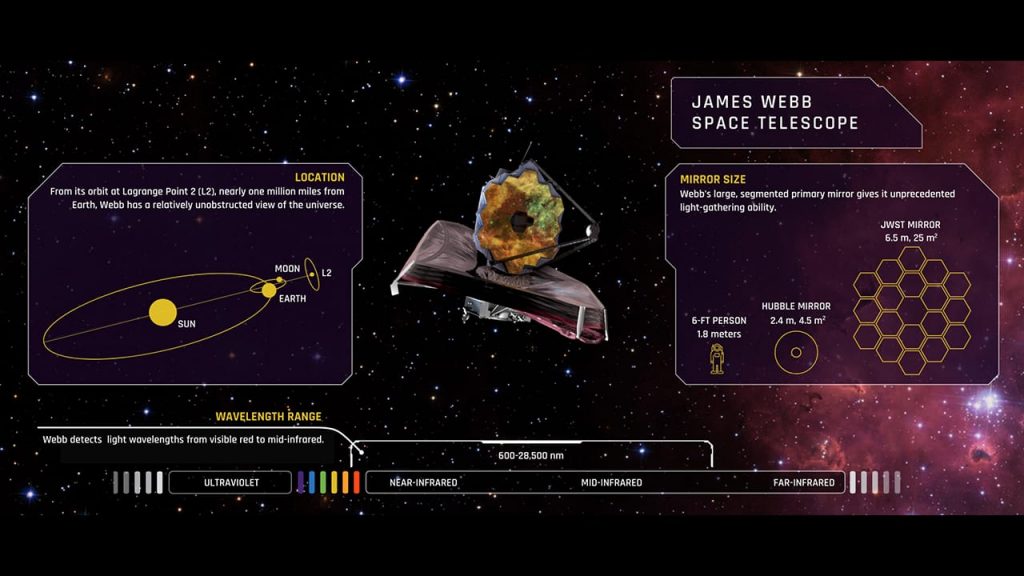
The JWST works by its prominence on infrared astronomy, based on the phenomena popularly known as cosmological red shift. Essentially, the greater the distance between us and an object in the universe, the ‘younger’ it appears. The reason is that the light takes longer to reach us.
The JWST will mainly focus on collecting light in the infrared range of the electromagnetic spectrum of light, and is expected to be able to quite literally ‘see back in time’ to events such as galaxy formation just a few hundred million years after the Big Bang.
It is difficult to predict exactly what the JWST might discover, but the prospects are very exciting. In a time when we are facing significant challenges on Earth, the potential for new discoveries beyond our planet is refreshing. As stated by Amber Straughn, the deputy project scientist for the JWST at the NASA Goddard Space Flight Center, big steps such as this in astrophysics can allow us to “learn things that we never expected”.
Conclusion
Therefore, the present-time bundle of light smacking a telescope does not exactly match the appearance of the distant galaxy that first created light millions of years ago; it is redder.
Fortunately, scientists now understand the redshift and can adapt to shift the light pattern back by the appropriate and concise amount in order to end up with a conclusive representation of the distant galaxy when it emitted the light.
Evidently, light patterns from distant galaxies can travel undisturbed for millions of years for two reasons:
- The distant galaxies are so far away that it simply takes millions of years for their light to travel this distance in a straight line.
- The universe is mostly empty so that light can travel a long way without hitting anything.
Thank you
If you find something intriguing in our article that surprises you, do let us know in the comment section below or share your feedback by mailing us.
Until then, stay tuned till we come up with something more exciting and intriguing. Till then happy reading, happy learning and remembering to support us!
Regards
Admin- The Globe’s Talk
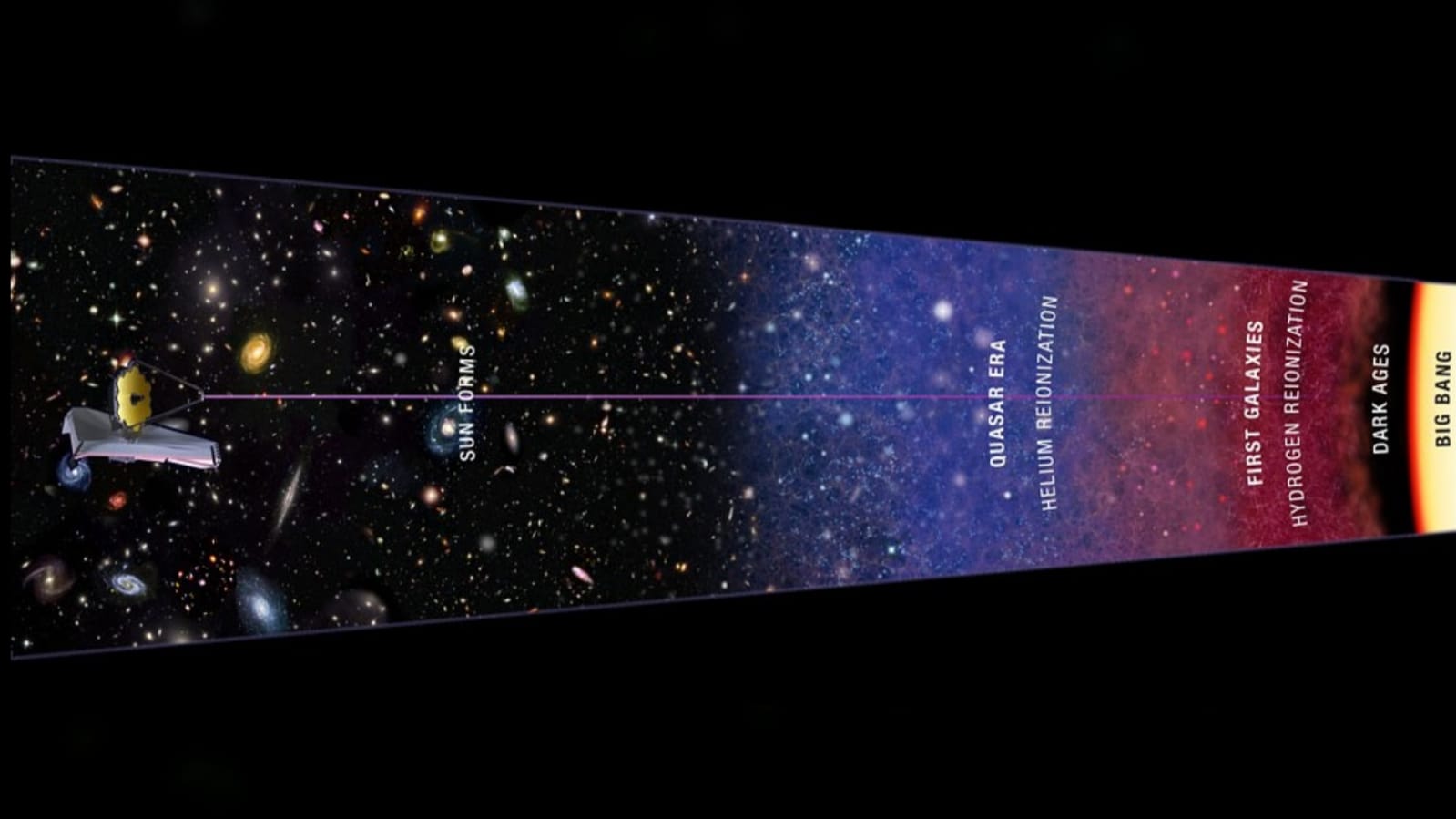
This is so clearly written it’s the first time I’ve truly grasped what is going on with the JWST. It’s a relief to ponder all this and kind of “get” it! Clear, helpful, and well-presented…thank you.
Hi PDL,
Thank you for being a genuine reader. I’m glad you liked this. Your feedback encourages us. It’s so nice that you could take the time to share your valuable insights with us.
Regards,
Admin-Theglobestalk